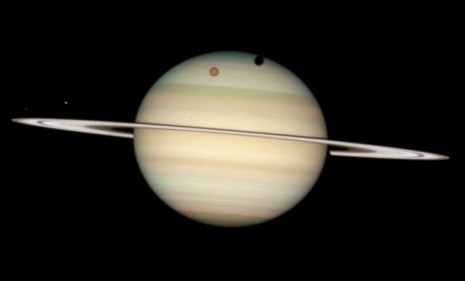The lost moon that gave Saturn its rings
The case of "cosmic murder" that explains the famous rings around our solar system's second largest planet

The spectacular concentric rings that circle Saturn have long baffled scientists. How were they formed? And why are they made mostly of ice? One team of researchers has come up with a new answer to those old questions — and it involves a scenario that's being called "cosmic murder." Here's a quick instant guide:
So how did Saturn's rings form?
Scientists agree that the planet's rings were formed by debris resulting from a midspace collision, either between a small moon and the planet, or a comet destroying a small moon. What they can't work out is why the rings are almost entirely made up of water. Any collision would have produced a mix of rock and ice, not the 95 percent ice found in the rings today.
The Week
Escape your echo chamber. Get the facts behind the news, plus analysis from multiple perspectives.

Sign up for The Week's Free Newsletters
From our morning news briefing to a weekly Good News Newsletter, get the best of The Week delivered directly to your inbox.
From our morning news briefing to a weekly Good News Newsletter, get the best of The Week delivered directly to your inbox.
How does this new theory explain the icy rings?
The idea put forward by a team of researchers at the Southwest Research Institute of Boulder, Colo., is that a larger-than-average moon was destroyed in a collision with the planet billions of years ago. They suggest that the moon had its outer layers of ice stripped off it as it spiraled toward Saturn, pulled in by the planet's gravitational force. The ice formed massive rings, while the rocky remains of the moon would then have been driven into the planet.
Why aren't the rings 100 percent ice?
Initially, they would have been. They also would have been 100 to 1,000 times larger than the rings of today. But over time, parts of the rings have coalesced into moons — Saturn has 62 of them that we know about — and the remaining ice has been polluted by asteroids and other space detritus.
A free daily email with the biggest news stories of the day – and the best features from TheWeek.com
How is this "cosmic murder," then?
The unnamed moon was the victim, explains The Associated Press, the main suspect was a "disk of hydrogen gas" that had circled the planet and created the conditions for ring formation "but has now fled the crime scene." The "cause of death" was a "forced plunge into Saturn." As for the planet itself? It "was an accomplice," says astronomer Robin Canup.
How will this theory be tested?
For one thing, we'll get more information about Saturn in 2017, says Alexandra Witze at Wired, when NASA's Cassini probe reports back after its "grand tour" of the planet. Scientists hope the probe will reveal more detail about the rings' density and evolution.
Sources: Associated Press, National Geographic, Wired, Discovery
-
 6 lovely barn homes
6 lovely barn homesFeature Featuring a New Jersey homestead on 63 acres and California property with a silo watchtower
-
 Film reviews: ‘Marty Supreme’ and ‘Is This Thing On?’
Film reviews: ‘Marty Supreme’ and ‘Is This Thing On?’Feature A born grifter chases his table tennis dreams and a dad turns to stand-up to fight off heartbreak
-
 Political cartoons for December 14
Political cartoons for December 14Cartoons Sunday's political cartoons include a new White House flag, Venezuela negotiations, and more